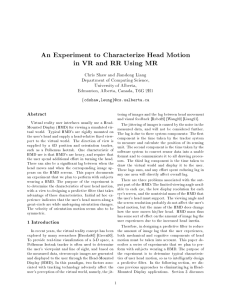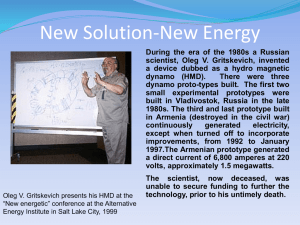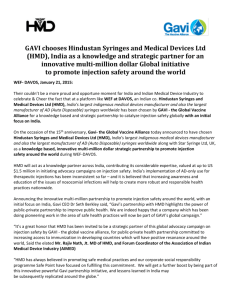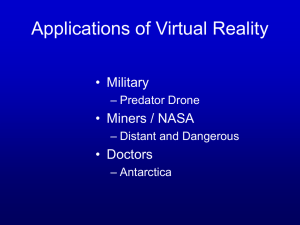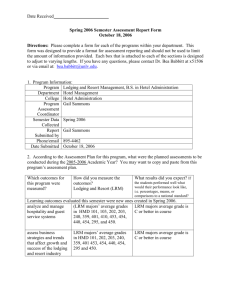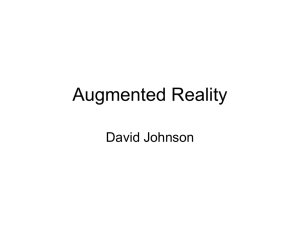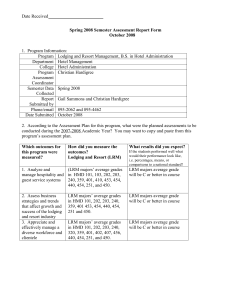An Integrated Approach to the Provision of Humanitarian Aid:
advertisement
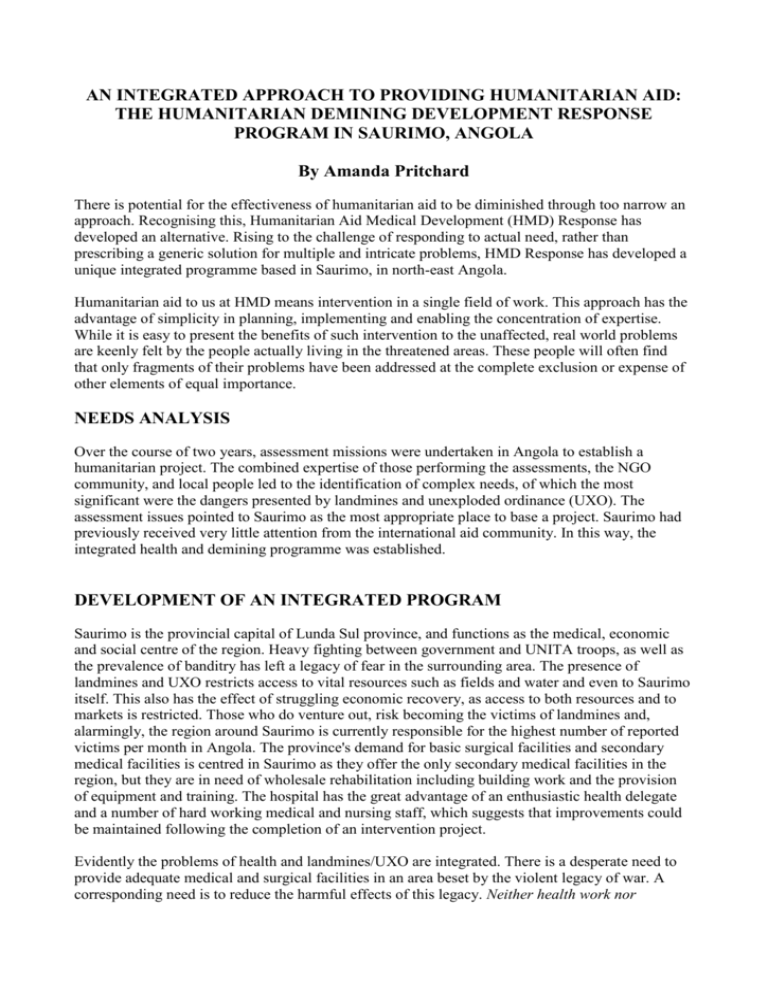
AN INTEGRATED APPROACH TO PROVIDING HUMANITARIAN AID: THE HUMANITARIAN DEMINING DEVELOPMENT RESPONSE PROGRAM IN SAURIMO, ANGOLA By Amanda Pritchard There is potential for the effectiveness of humanitarian aid to be diminished through too narrow an approach. Recognising this, Humanitarian Aid Medical Development (HMD) Response has developed an alternative. Rising to the challenge of responding to actual need, rather than prescribing a generic solution for multiple and intricate problems, HMD Response has developed a unique integrated programme based in Saurimo, in north-east Angola. Humanitarian aid to us at HMD means intervention in a single field of work. This approach has the advantage of simplicity in planning, implementing and enabling the concentration of expertise. While it is easy to present the benefits of such intervention to the unaffected, real world problems are keenly felt by the people actually living in the threatened areas. These people will often find that only fragments of their problems have been addressed at the complete exclusion or expense of other elements of equal importance. NEEDS ANALYSIS Over the course of two years, assessment missions were undertaken in Angola to establish a humanitarian project. The combined expertise of those performing the assessments, the NGO community, and local people led to the identification of complex needs, of which the most significant were the dangers presented by landmines and unexploded ordinance (UXO). The assessment issues pointed to Saurimo as the most appropriate place to base a project. Saurimo had previously received very little attention from the international aid community. In this way, the integrated health and demining programme was established. DEVELOPMENT OF AN INTEGRATED PROGRAM Saurimo is the provincial capital of Lunda Sul province, and functions as the medical, economic and social centre of the region. Heavy fighting between government and UNITA troops, as well as the prevalence of banditry has left a legacy of fear in the surrounding area. The presence of landmines and UXO restricts access to vital resources such as fields and water and even to Saurimo itself. This also has the effect of struggling economic recovery, as access to both resources and to markets is restricted. Those who do venture out, risk becoming the victims of landmines and, alarmingly, the region around Saurimo is currently responsible for the highest number of reported victims per month in Angola. The province's demand for basic surgical facilities and secondary medical facilities is centred in Saurimo as they offer the only secondary medical facilities in the region, but they are in need of wholesale rehabilitation including building work and the provision of equipment and training. The hospital has the great advantage of an enthusiastic health delegate and a number of hard working medical and nursing staff, which suggests that improvements could be maintained following the completion of an intervention project. Evidently the problems of health and landmines/UXO are integrated. There is a desperate need to provide adequate medical and surgical facilities in an area beset by the violent legacy of war. A corresponding need is to reduce the harmful effects of this legacy. Neither health work nor demining alone can provide an adequate response to this problem, but that the two must be tackled together. In so doing, the HMD Response also been able to realize wider benefits for the local population which would not have been possible if a narrower project had been pursued. IMMEDIATE BENEFITS OF AN INTEGRATED APPROACH The immediate benefits of an integrated approach are threefold: shared personnel, shared information and greater impact. Shared Personnel. A single project manager ensures consistency of approach and has provided continuity and control through the first crucial months of the project. The advantages of this are most strikingly illustrated by the paramedics. Six paramedics are employed by HMD Response to work in the minefields. To maintain their skills through constant practice, they rotate through the hospital emergency room. In addition to developing their competence, this has the effect of raising standards in the hospital, which benefits the entire local population and ensures that skilled paramedic support is available to the deminers both in the field and, in case of emergency, in the hospital as well. Shared Information. Information is crucial to the success of any humanitarian program, and HMD Response benefits from the ability to gather information from many different sources. Information gathered through mines survey and mines awareness work, as well as through actual clearance, is added to that provided by the patients attending the hospital who report on the location of mines and UXO as well as on UNITA or banditry attacks. This information can then be used in planning the next steps in the program. It can help set immediate priorities and, obviously it can be disseminated throughout the local population as part of HMD Response's overall concern to improve their safety. Greater Impact. The HMD Response Program has a far greater impact on the local population as a result of its integrated approach. People have learned to recognise the HMD Response name and look upon it with great respect. The reception HMD Response receives is doubly encouraging as the name is evidently associated with both demining and health improvement. For example, it is now the norm for HMD Response to be called by the hospital's staff if a mine victim arrives. Similarly, it is clear from hospital records that victims of landmines, UNITA, or banditry attacks are increasingly travelling long distances to get to that hospital as its reputation for the provision of emergency services has grown. WIDER BENEFITS Of THE INTEGRATED APPROACH HMD Response also has a unique ability to help communities by providing health education and assistance to those areas where mines awareness or clearance are taking place. The Angolan Ministry of Assistance and Social Reintegration (MINARS) when providing both mine awareness and UXO clearance aid recently approached HMD Response to set-up and run a health post at the newly established Internally Displaced Persons (IDP) Camp at nearby Luari. HMD Response was ideally placed to offer a rapid response to this emergency situation due to the integrated nature of its work. The aims of HMD Response's work are to improve the health, safety and standard of living of the population of Saurimo and Luanda Sul province and an integrated approach ensures these broad aims can be a reality. This approach aims to realize these aims through the regeneration of the local economy, the sustainability of improvements, and the rebuilding of infrastructures. REGENERATION OF THE ECONOMY BY OVERCOMING FEAR One of the consequences of two decades of the haphazard and zealous laying of landmines is confusion and fear. While there is a very real existence of mines in the region preventing access to water and land and precluding safe travel on road, there is also a parallel problem created by the fear of mines, whether they are actually there or not. Mines survey and mines awareness combined with UXO clearance can open up areas rapidly and effectively by differentiating between those areas where fear alone is the enemy, and those areas where mines themselves present the real danger. HMD Response has the capability to carry out basic mine surveys and awareness activities, but it also has the capacity to conduct actual clearance operations. Where there is doubt about the presence of mines, or their existence has been positively confirmed, HMD Response can still help the local community by clearing safe routes to vital resources. The effect of this work is to improve the ability of the family to feed itself and gain access to clean water, and to improve the ability of the community to engage in trade through improved access to resources and markets. Ultimately the effect of this work is to improve the ability of the local population to become self-sufficient and regenerate itself. SUSTAINABILITY Economic The gradual reestablishment of the local economy has both immediate and long-term health benefits. In the short-term, both the ability to have a greater selection and quality of food, combined with the opportunity to purchase a wider variety of medicines have a significant impact on the health of the population. The longer-term benefits are also substantial. The viability of the local hospital depends on the ability of the local community to afford its services. The hospital relies on income from the government, collected through taxes, just as it relies on the ability of its patients to buy the medicines they have been prescribed. In Saurimo, the prognosis for the continued improvement of the hospital is good because there is sufficient capacity within the local community to ensure its continued viability. One of the biggest obstacles to national renewal in Angola is the permanent political and military instability in the country. Although this situation is national in character and its leading protagonists display little interest in creating a permanent peace, on a local level there is much that can be done to improve the situation. By focusing on health, HMD Response's program benefits the whole population, and through the training and employment opportunities it is creating, HMD Response aims to give people from all sides of the conflict the chance to participate meaningfully in the community. Similarly, the demining work undertaken by HMD Response is contributing to the process of reopening access routes throughout the area, which again helps to breakdown the barriers created by many years of civil war. DEMAND FOR HOSPITAL SERVICES By clearing access routes to Saurimo, HMD Response is helping to ensure that people will be able to get to the hospital quickly and easily to receive the treatment they need. This means that demand for hospital services will continue to grow, thereby promoting the long-term viability of the hospital. It also contributes to the sustainability of the program by ensuring that the medics and nurses at the hospital continue to see the necessary range and number of patients to maintain their skills. HELPING DISPLACED PERSONS The effects of the emergency work carried out by HMD Response are also maximised because of the people’s increased ability to get around. Mines awareness work is vital in the Luari Internally Displaced Persons (IDPs) Camp because of the existence of UXO in the area. As the camp inhabitants start to leave to find new homes, or return to old ones, the need to be alert to the danger of mines and UXO becomes even more important. Hopefully, by surveying and clearing mines, HMD Response can facilitate the return of IDPs, and through both its mines awareness and health improvement work, HMD Response can equip them for a safe and healthy journey. REBUILDING OF INFRASTRUCTURES Saurimo hospital is the bedrock of the health service in the region. A relatively centralised service is the only effective option for the provision of health care in this area, as local clinics have neither the resources nor the personnel to cope with the range and complexity of health problems experienced by the population. However, local clinics do provide a vital service in treating the many minor ailments that require attention at a primary care level, and in teaching the local people about better health care. By opening up access to these clinics, and establishing a working infrastructure based around the hospital, incorporating referrals and the transfer of expertise, HMD Response's program can be seen to be contributing to the long-term renewal of the health service in Angola. CONCLUSION Although the integrated program developed by HMD Response in Saurimo is far more complex and challenging than the traditional technique of intervening in a single field of work, it has proved to be an effective and rewarding approach. The project is both more efficient and more effective because of the sharing of personnel and information, and its impact on the local community is maximized. Importantly, this integrated approach has enabled HMD Response to be more responsive to the changing needs of the population and to meet not only their immediate, but also their long-term requirements. Sustainability and practical regeneration are the enduring rewards for this unique approach to the problems faced by the people of northeastern Angola, and they are a testament to its success.
